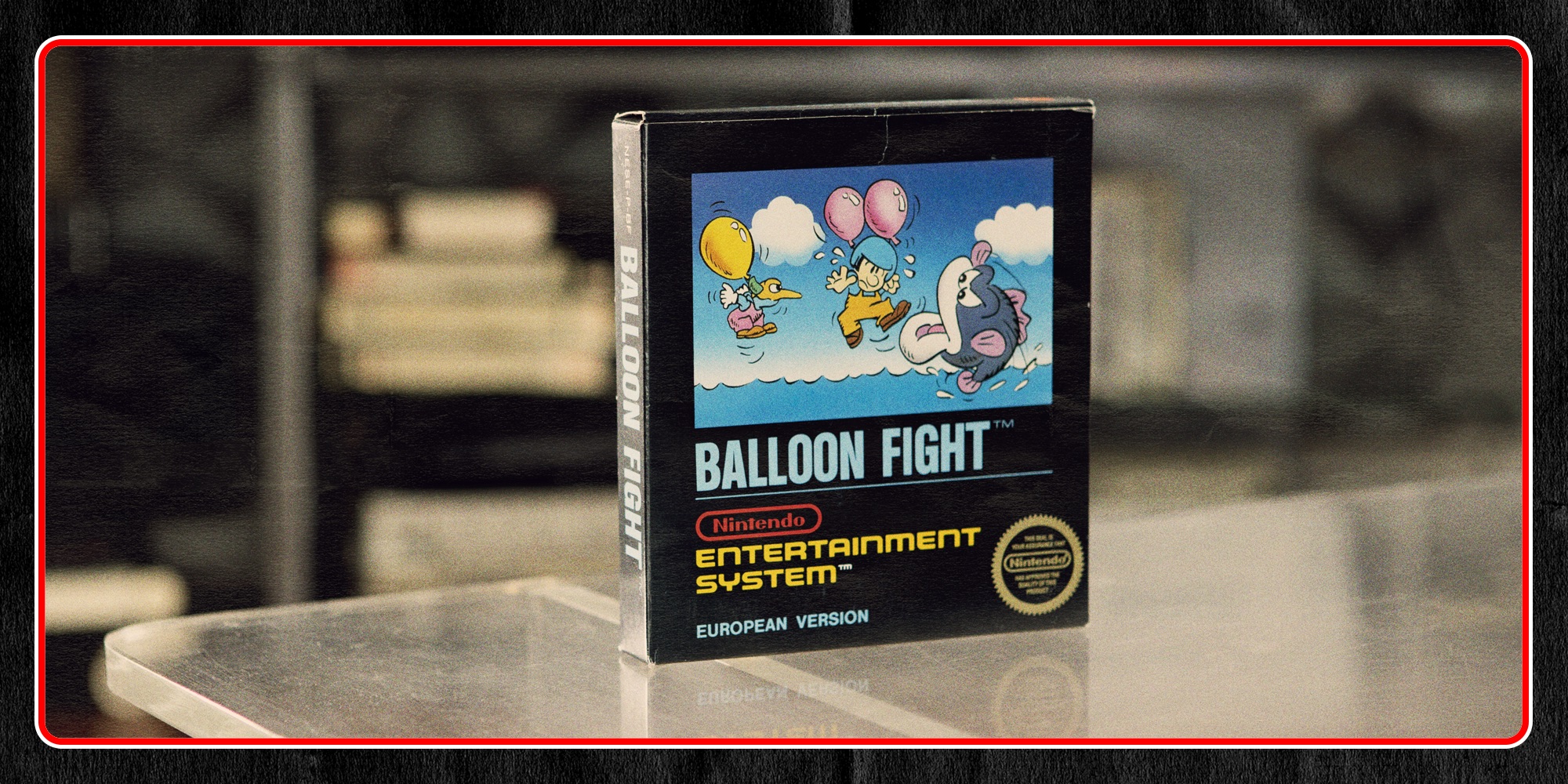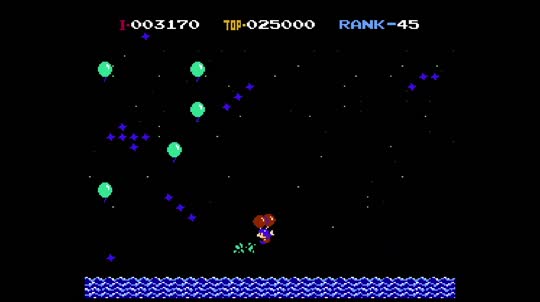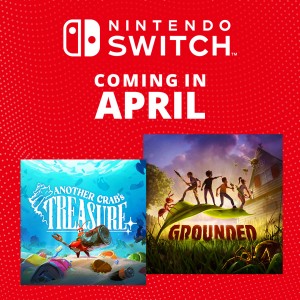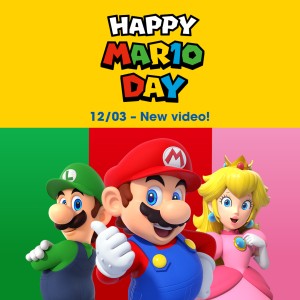Nintendo Classic Mini: NES special interview – Volume 2: Balloon Fight
11/11/2016


1. Famicom: Family Computer. The NES is known as Famicom in Japan.
The developer who made this game was Yoshio Sakamoto. Sakamoto-san has worked on many games, from the Metroid, WarioWare and Rhythm Paradise series to Tomodachi Life and the smart device application Miitomo, but it was only his third year at the company when he developed Balloon Fight. I asked him about how he felt as a young man working on this game and about any interesting events that happened along the way, so I hope you’ll read to the end.
And now for the interview…

Volume 2: Balloon Fight
If You Can Draw, You Can Make Games
Sao: The arcade game Balloon Fight came out in November of 1984, and the Famicom version came out in Japan in January the next year, which was your third year at Nintendo.
Sakamoto: I joined the company in 1982, so that’s right.
Sao: What did you work on before Balloon Fight?
Sakamoto: I began as a designer for Game & Watch2. At first, I just helped out, but I also became responsible for making some of the Game & Watch titles.
2. Game & Watch: A line of handheld game devices with LCD screens, each of which contained one game. The first game was released in Japan in 1980, and the line went on to sell a total of 43.4 million devices worldwide.
Sao: Which titles did you work on?
Sakamoto: There were several. Have you heard of the Panorama Screen?
Sao: Yes. The Game & Watch series that had a colour LCD screen.
Sakamoto: That series had titles like Snoopy3, Donkey Kong Circus4, Mario’s Bombs Away5, and so on. I worked on all of those.
3. Snoopy: A game in which Snoopy uses a hammer to hit musical notes coming from a piano.
4. Donkey Kong Circus: A game in which Donkey Kong stands atop a barrel and tries to keep pineapples aloft.
5. Mario’s Bombs Away: A game in which Mario runs around the jungle and attempts to stop a bomb from being lit.
Sao: Oh, I see. What games did you work on after Game & Watch?
Sakamoto: The arcade game Vs. Wrecking Crew6. Back then, my boss Gunpei Yokoi7 believed that if you can draw, you can make games. So I would continue drawing as I designed games. Of course, I had to consult Yokoi-san about many things.

6. Vs. Wrecking Crew: An arcade game that appeared in 1984 in Japan.
7. Gunpei Yokoi (1941-1997): During his time at Nintendo, Yokoi-san worked on game devices such as Game & Watch and Game Boy, and he was an integral figure in development of such products as Robotic Operating Buddy (R.O.B.) and Dr. Mario.
Sao: I see.
Sakamoto: That was when I began drawing pixel art.
Sao: Game & Watch didn’t use pixel art, so you began drawing pixel art with Vs. Wrecking Crew.
Sakamoto: That’s right.
Sao: You were also involved with the NES version of Donkey Kong Jr.8, weren’t you?
8. Donkey Kong Jr.: An arcade game that appeared in 1982. The NES version was first released in Japan in 1983, and in Europe in 1987.
Sakamoto: Yes, I just helped out [Shigeru] Miyamoto-san a little. So I worked on things like the logo, title screen and Donkey Kong locked in a cage.
Impossible Bubbles
Sao: Then you made Balloon Fight. How did that come about?
Sakamoto: Yokoi-san suggested making a game focused on giving players a sense of floating through space that also has fighting elements.
Sao: Because, “If you can draw, you should be able to make games,” right?
Sakamoto: Right. So I drew some pictures and became responsible for the game design. SRD Co.9 was in charge of programming for the arcade version, and Satoru Iwata10, who was at HAL Laboratory, Inc. at the time, was in charge of the NES version.
9. SRD Co., Ltd. is a company established in 1979 that develops video game software programs for other software companies, and develops and sells CAD packages. Their headquarters are located in Osaka, and the Kyoto branch is located inside the Development Centre at Nintendo headquarters. The company president is Toshihiko Nakago.
10. Satoru Iwata (1959-2015): Nintendo’s former president.
Sao: Were both the arcade and the NES versions made at the same time?
Sakamoto: About the same time. But my memory about that isn’t clear.
Sao: That was over 30 years ago, so you’ve probably forgotten a lot.
Sakamoto: Yeah. But I remember some things clearly. You know how a bubble rises when you drop an opponent into the sea in Balloon Fight?
Sao: Yes. And if you pop it, you get points.
Sakamoto: That happened when Yokoi-san suddenly told me to make bubbles one day, but at first I replied that I thought it was impossible.
Sao: Why did you think that?
Sakamoto: The graphics in the NES era were much too simplistic. I thought it would be impossible to make something like a bubble that looked transparent.
Sao: Oh, uh-huh.
Sakamoto: But Yokoi-san scolded me, saying I shouldn’t say I can’t do it before I’ve even tried.
Sao: (laughs)
Sakamoto: He told me to try, and I said I didn’t think it could be done but I would give it a try, and when I did…
Sao: And when you did?
Sakamoto: It was a piece of cake! (laughs)
Sao: (laughs)

Sakamoto: We had a basic development tool at the time that we were able to experiment with. Yokoi-san was watching by my side and said, “You see? You got it to work.” (laughs) It turned out to be really easy, so I regretted my earlier attitude. Since then, I’ve tried not to say “That’s impossible,” or “I can’t do it.”
Iwata-san and the Dashing Grey-Haired Gentleman
Sao: Yokoi-san was born in 1941, so there was about a 20-year age gap between you and Yokoi-san.
Sakamoto: Yes. To be exact, I was 18 years younger.
Sao: And you were the same age as Iwata-san.
Sakamoto: Yes, even the same school year.
Sao: When Balloon Fight was in development, Yokoi-san was the producer and Iwata-san programmed the NES version. Do you have any particular memories of those two from that time?
Sakamoto: Yes. I remember two things clearly. One is something I heard from Iwata-san and the other is something I actually saw. I’ll start with what Iwata-san told me.
Sao: All right, please go ahead.
Sakamoto: When we made Balloon Fight, we had Iwata-san come to Kyoto to do all sorts of work in a room prepared for him at Nintendo.
Sao: At the time, I think HAL Laboratory, Inc.’s head office was in Tokyo instead of Yamanashi, so that means you had him come all the way to Kyoto to do his programming work.
Sakamoto: He didn’t stay all the time, but he would come every once in a while. He holed up alone in a room and started working, but suddenly a dashing grey-haired gentleman came in and, without saying anything, planted himself in a chair and for a long time played Balloon Fight – which was still under development.
Sao: A dashing grey-haired gentleman?
Sakamoto: That was Yokoi-san.
Sao: Oh!
Sakamoto: Iwata-san wasn’t sure how to react.
Sao: Ah, because Iwata-san didn’t know Yokoi-san?
Sakamoto: Right. They weren’t acquainted yet. Then, after playing for a long time, Yokoi-san told him to fix this and that and then left the room. Iwata-san wondered who that man was, so he later asked us and finally learned it was Yokoi-san. Iwata-san told me that story himself.
Sao: So that’s what happened.
Sakamoto: Isn’t it a great story?
Sao: I love it. It’s very much like Yokoi-san to play the game in silence and then point out problems.
Making Balloon Trip in Three Days
Sakamoto: Now for what I saw myself.
Sao: All right.
Sakamoto: It happened when we were making Balloon Trip.
Sao: Balloon Trip is a single-player, side-scrolling game in Balloon Fight. Apparently, Iwata-san made it in just three days.
Sakamoto: That’s right. It came from an inspiration Yokoi-san had. He told us what kind of vision he had for the game and Iwata-san basically made it in three days. About the time the game was reaching completion, Yokoi-san came up to Iwata-san and myself. He and Iwata-san were acquainted by that time, so after a brief greeting he started playing Balloon Trip. And as usual, he played for a long time.
Sao: Of course! (laughs)
Sakamoto: Then, after playing through, he told Iwata-san a bunch of things he’d like to have fixed, but they weren’t easy fixes. I say this because at the time, programmers would put out on paper what they had programmed and then do corrections while consulting a stack of paper as thick as a phone book.
Sao: Those were difficult times.
Sakamoto: Just fixing a few places would take at least an hour, so Yokoi-san must have intended to go back to his desk and have a cup of coffee or something until the revisions were finished. But when he stood up to leave, Iwata-san said, “Just hold on a sec,” and began typing away on the keyboard. Then he said, “All done!”
Sao: Whoa!
Sakamoto: I was amazed that he could make the revisions so quickly, and even today I remember how Yokoi-san exclaimed, “Already?!”
Sao: That’s incredible…I’m speechless!
Sakamoto: Iwata-san had memorised the program.
Sao: Everyone considered Iwata-san a genius programmer, but hearing that story makes me realise it all over again.
Sakamoto: Yes, it really does.
“I’m Glad Yokoi-san Said, ‘Make it.’”
Sao: Balloon Trip wasn’t in the arcade version of Balloon Fight, but I suppose you ended up adding it to the NES version because Yokoi-san wanted more gameplay.
Sakamoto: Yes, I believe so. The player select screen offered two modes: ‘A’ for single-player and ‘B’ for two-player. I imagine he thought the two modes wouldn’t be enough, and wanted to add ‘C’.
Sao: Oh, I see. He decided to make Balloon Trip option ‘C’. That does make a big difference.
Sakamoto: Yes, it does.
Sao: If you consecutively pop 20 floating balloons…
Sakamoto: Your balloon turns orange. I liked Balloon Trip the best, so I enjoyed challenging myself to see how far I could go. It feels great once you clear the highest score to see the numbers shooting up every time you move. At first, the controls are a bit difficult, but once you get used to them, you can move however you want.

Sao: It feels great to slip past things.
Sakamoto: And it felt great when I became able to snag a bubble, stop scrolling, and go back a bit to get something I missed.
Sao: Right.
Sakamoto: Looking back, I’m glad Yokoi-san said, “Make it.”
Sao: Yes. By the way, how was your personal experience working on this game?
Sakamoto: For me, it was the second video game that I had been deeply involved with. At first, when I worked on Vs. Wrecking Crew, I got the chance to do various visuals, and while drawing is also challenging, putting a game together was a great challenge. But I learned quite a bit from all the obstacles I had the first time, so Balloon Fight was much easier.
Sao: You’d gotten the hang of making video games.
Sakamoto: Perhaps. But there was, of course, a lot of trial and error. Having a character hang from two balloons was an integral element of the game design, so I had to figure out how to manage that. And I was thrilled when I pulled off the movement of the enemies on platforms who use pumps to blow up balloons. (laughs)
Sao: The way they move as they pump away at those balloons is cute. (laughs)
Sakamoto: So I was able to make Balloon Fight without fretting too much, and if I may say so myself, I felt like I had grown a little when I worked on my second game.
A Dream Becomes Reality Ten Years Later
Sao: To finish up, could you mention how you recommend playing Balloon Fight?
Sakamoto: In a meeting with somebody from another company, we talked about the Classic Mini NES and Classic Mini Famicom*.
*In Europe, only Nintendo Classic Mini: Nintendo Entertainment System will be available.
Sao: Uh-huh.
Sakamoto: That person said he wanted to take it to a hot spring and play it while socialising. I thought that sounded fun, too.
Sao: Yes, it does! (laughs)
Sakamoto: It would be fun for a group to stay at a traditional-style inn, wear yukata11, socialise and play Balloon Fight.
11. Yukata: a traditional Japanese garment made from cotton or synthetic fabric, usually worn in summer.
Sao: It’s light and compact, so it would easily fit in a travel bag.
Sakamoto: You could be playing two-player co-op. Your partner can have fun failing on purpose and blame it on you. (laughs)
Sao: (laughs) It would also be fun to compete to see who gets the most balloons in Balloon Trip.
Sakamoto: The controls take a little getting used to, so it will be great if parents who once played the game teach their children how to play.
Sao: By the way, what are your impressions of the Classic Mini NES and Classic Mini Famicom, which include Balloon Fight?
Sakamoto: They’re perfect!
Sao: Perfect?! (laughs)
Sakamoto: To be honest, I said I wanted to do something like this 10 years ago.

Sao: Really?!
Sakamoto: I thought it might be interesting to make a Game Boy Advance that can display games on a TV monitor with the appearance of a Famicom, and I even made a mock-up.
Sao: Upon the 20th anniversary of the Famicom, the NES Classics series of games came out on Game Boy Advance, but…
Sakamoto: Yes, that was part of the same impetus. I did that in my spare time.
Sao: And you even made a mock-up?
Sakamoto: Yep, that’s right.
Sao: How would it compare size-wise to the Classic Mini NES or Classic Mini Famicom?
Sakamoto: It was about the same, or maybe a little smaller.
Sao: And you could insert Game Boy Advance games and play them?
Sakamoto: Yes. But the mock-up didn’t run. It just looked like a Famicom. But I also made the packaging.
Sao: Huh? Really? The packaging for the Classic Mini NES also recreates the packaging for the original NES, which is really cool.
Sakamoto: Yeah. Over 10 years ago too, I consulted the person who did the artwork, and I thought about a smaller package.
Sao: That project was just a bit ahead of its time. (laughs)
Sakamoto: Yeah, and it got shelved. I suppose it just wasn’t realistic at the time.
Sao: So you’re happy about the Classic Mini NES and Classic Mini Famicom?
Sakamoto: Yes, of course! It finally happened!
Sao: These products fulfil a dream you’ve had for over 10 years.
Sakamoto: Yes, they're perfect! (laughs)
Please look forward to Volume 3 of this interview series, which will be all about the NES classic Super Mario Bros.!
Nintendo Classic Mini: Nintendo Entertainment System is out now. Please check with your local retailer for information on current availability.





